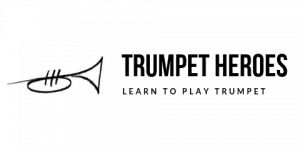Types of Trumpets is a yet another big chunk of territory so lets start on an easy trail. In North America almost everyone interested in this subject is playing on a piston valve Bb Trumpet. A few more are playing on Bb Cornets and the odd lucky one also has a Bb Flugelhorn.
The technique for all 3 is essentially the same and many professional players use them all. Some great players are best known for their work on just one but play the others too. (The deal with the Bb in front of the name is explained below.) The photo below shows a Trumpet at the back, a Flugelhorn in the middle and a Cornet in front.
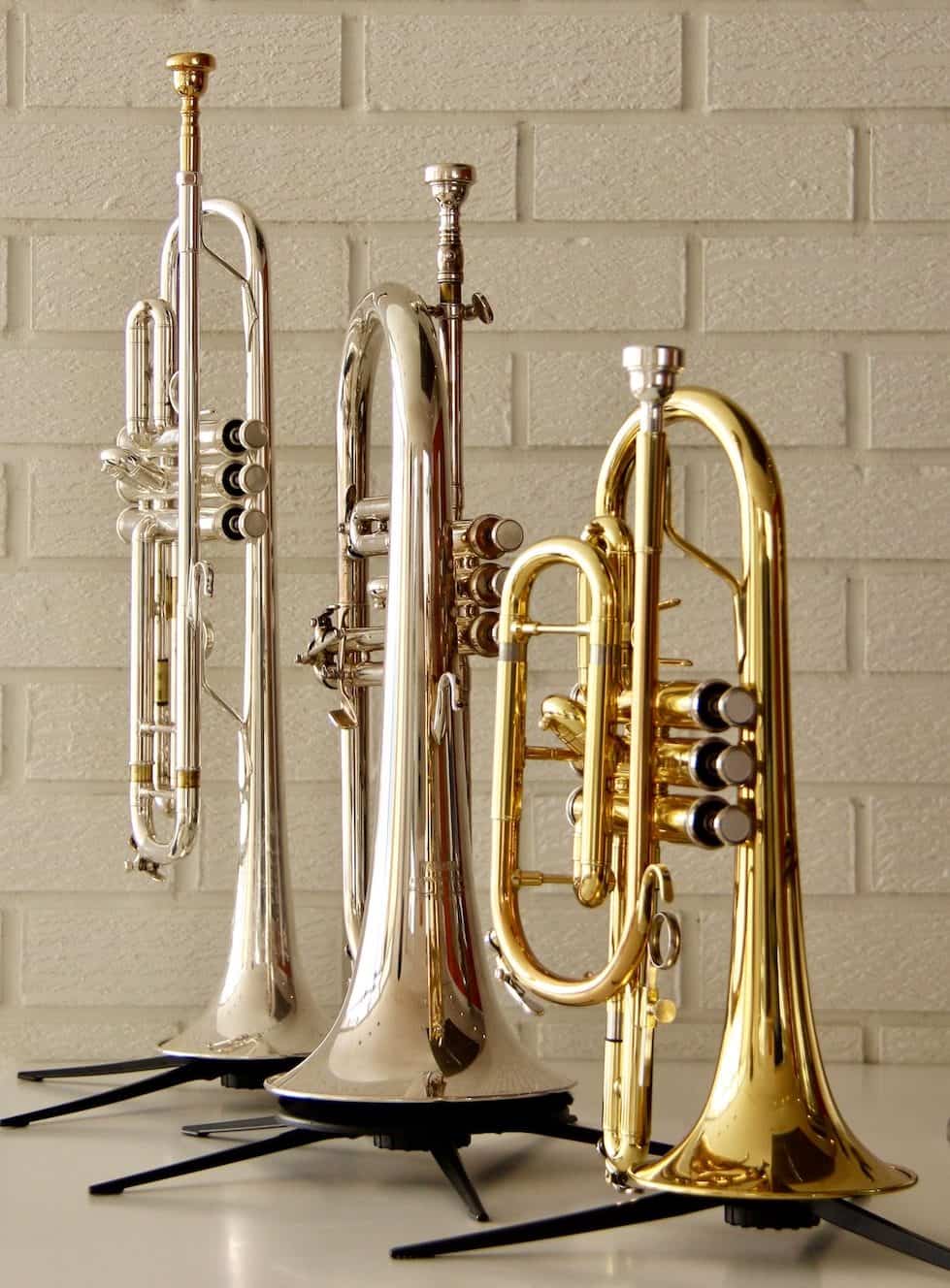
Tubing for Different Types of Trumpets
Most of the tubing in a Trumpet is (relatively) cylindrical and that produces its characteristically brilliant tone. The Cornet’s tubing is mostly conical and its tone is more mellow as a result. That tubing is the same length as a trumpet but most often bent differently so the horn ends up being shorter. The Flugelhorn is conical like the cornet but more extreme, so it sounds even more mellow. Flugelhorn bells are generally much bigger than Cornets or Trumpets. There are some other interesting differences but those are the main ones.
Valves on Trumpets
We have to park it for a minute and talk about valves. Without valves the trumpet is capable of playing only a select group of notes – the harmonic series if you’re into science; Bugle calls if you’re into Trumpet. Bugles need their own page so that’s on the way soon.
Why Trumpets Have Valves
Imagine a Trumpet hero showing up to a rehearsal a couple of hundred years ago – before valves were invented. The picture in my mind is one of a guy (yes, before valves also means before equal opportunity) pushing a wheelbarrow filled with trumpets of various lengths and miscellaneous extra bits of tubing. He sits down and flips through that day’s music, swears under his breath and rummages around in the wheelbarrow. While getting the trumpets and spare crooks required he looks enviously at the Sackbut player beside him. Some of his trumpets were twice as long as modern ones, so there were more notes available. Nothing has valves on it.
Hopefully you’ve noticed from the unusual TrumpetHeroes.com Beginning Fingering Chart that as you get higher the available notes get closer together. The longest trumpet we have these days is our Bb Trumpet with all 3 valves down and most high school Trumpet Heroes could play scale fragments in that fingering – but they don’t. Anyway, I digress.
The short version is that a given Trumpet could only play notes that sounded good in a couple of keys and composers wanted to write their music in a bunch of keys. Sometimes (ok, almost all the time) they would change keys in the middle of the piece. One solution was to simply leave out the Trumpets – unsatisfactory. The next choice was to have the Trumpet player switch instruments or pull out a part and replace it with a shorter or longer one. It took time, was a nuisance for the player and composers didn’t like being so limited in their use of such a great instrument. There were some interesting and sometimes hilarious solutions to this problem.
Another solution was to have multiple Trumpet players playing on different size Trumpets at the same time. At some point in the Classical period a clever instrument maker came up with a Trumpet that had holes in it and keys like a clarinet. Thank goodness or we wouldn’t have the Haydn Trumpet Concerto. My personal favourite solution is the 7-belled Cornet above. That instrument maker used valves to make trumpets of different lengths attached to the same mouthpiece but each led to its own bell. (You can see a new one like it at 7:37 in Jens Lindeman’s video from the Yamaha Trumpet factory – those folks know how to have fun!) Anyway, eventually the idea of valves was improved upon to the point where they fed the air back into each other and into one bell. This innovation made Trumpets more useful to composers who could write those “in between” notes that Trumpets couldn’t previously play. The valves were mostly built onto Cornets for a while and there is a lot of good music that comes with Cornet parts that are relatively melodic and Trumpet parts that look more like Bugle calls. We know that the two sound somewhat different but nowadays most Cornet parts are played on Trumpets on this side of the world. The valve design of choice in most of the world is the piston valve like these:
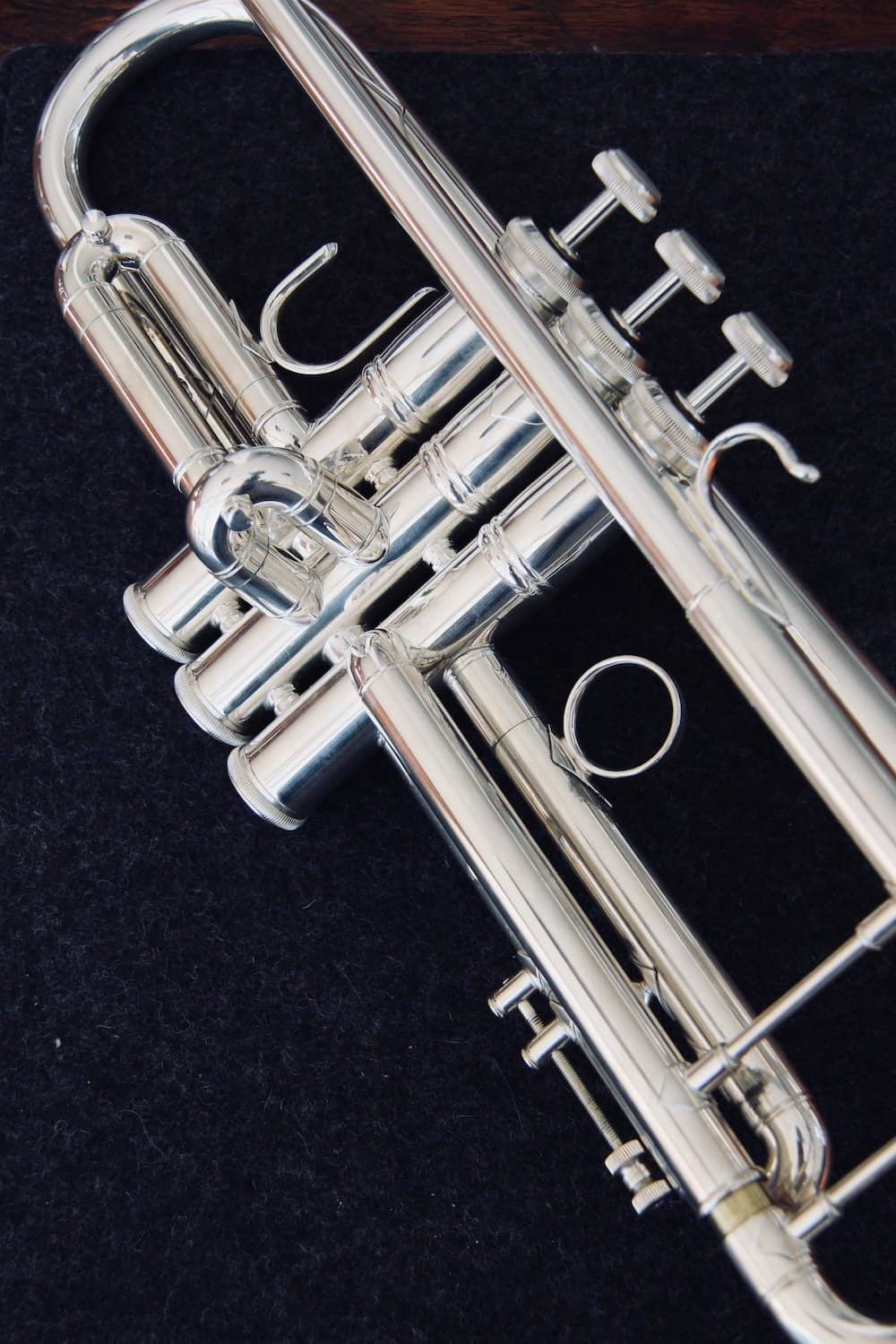
Rotary Valve Trumpets
In Europe, and particularly in German-speaking countries, rotary valve trumpets are preferred. They do the same thing as piston valve instruments but most players and quite a few conductors will insist that they sound different. The only difference that makes sense to me has to do with the the milliseconds of change from one note to the next. There is something gentler about it. If you’ve ever driven an RX-7 you know how different the acceleration feels from an Ecoboost. It’s like that. In fact the development of these instruments has been on a separate, parallel track to the American style piston valve Trumpet so there are lots of differences in how they play and sound. (Click here to read more about these instruments. Trumpet sections in major orchestras around the world will sometimes pull out their rotary valve Trumpets for playing symphonies and operas etc. by German and Austrian composers. One day I’ll win a lottery and buy my orchestra a matched set in Bb and C! Here’s a photo I shamelessly found on the internet.
Trumpets in Various Keys
Composers were in the habit of writing for Trumpets of a variety of lengths, and Trumpet players did what they had to do with their wheelbarrows. Instrument makers eventually put valves on all kinds and sizes of instruments and must have had some interesting discussions about what sounded best, what worked best and who knows what other variables. The length that became the most popular was the one where the first open notes (no valves down) produced a Bb concert triad. That didn’t happen overnight so all sorts of interesting sizes and systems were created. The Bb Trumpet became and remains the most standard instrument. Trumpet players learn one set of fingerings and note-names that work on all trumpets. The tricky thing is that the open notes on the different lengths match different notes on – for instance – a piano. So, as the first open notes on a Bb Trumpet produce a Bb major triad the player calls them C, G, C, E and G. On a D Trumpet those first notes produce a D major triad yet the player calls them C, G, C, E, and G. On a Piccolo trumpet in A the first open notes produce an A major triad and the player – you guessed it – calls them C, G, C, E, and G. We learn one set of fingerings and use them on Trumpets built in various keys.
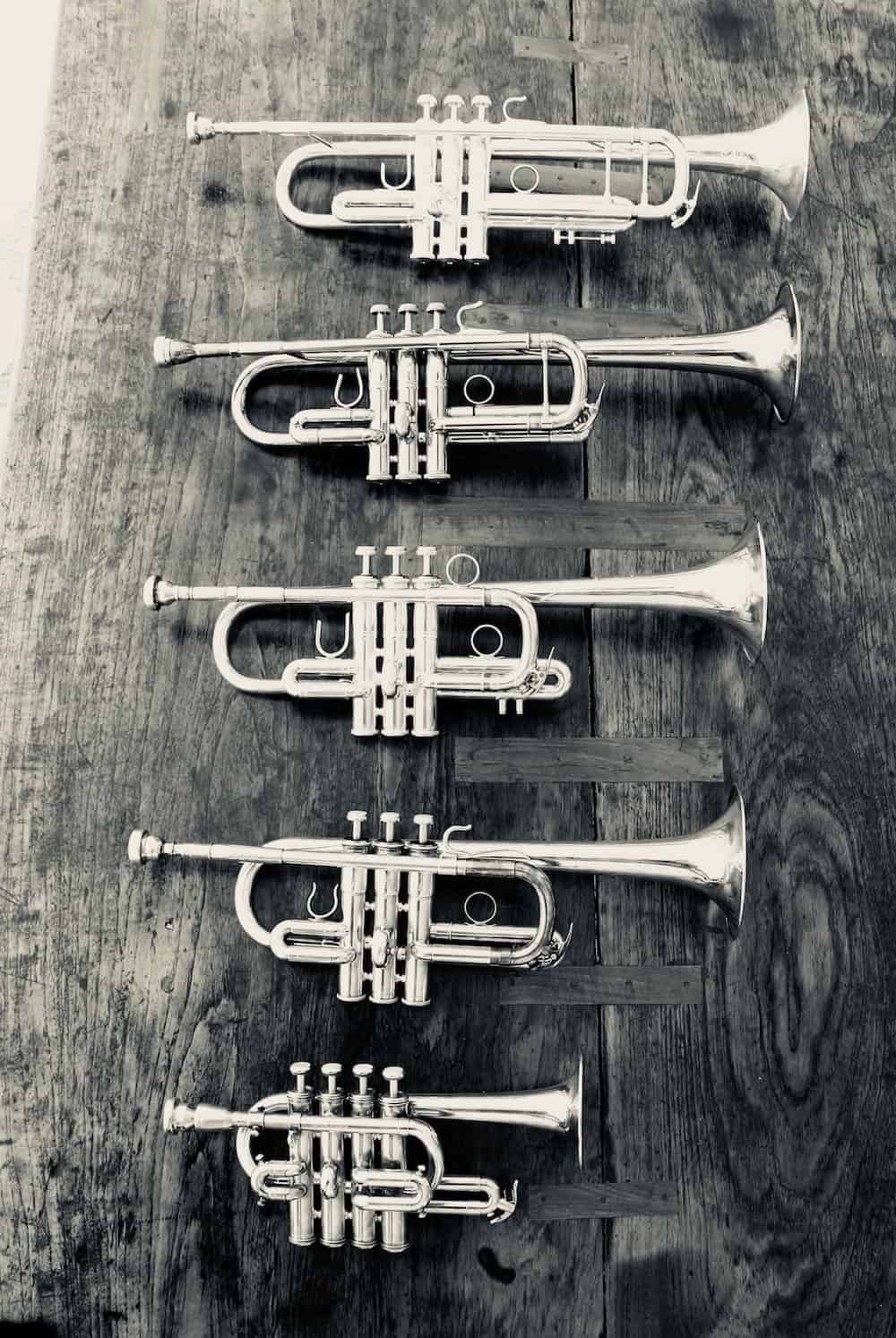
Top to bottom are Trumpets in Bb, C, D, Eb and Piccolo in Bb
Concert pitch
For most of us this business only matters because when we play our Bb instruments in the company of others we sometimes have to hear about “concert pitch”. Concert pitch is simply the idea that things like piano, organ, string instruments, flutes, oboes and some of their friends have set their “C” as the standard C. If Bb instrument players like us want to play with them we have to take what we think of as the right notes and play them up a whole step to get us from Bb to C. We have some friends out there: Tenor Saxophones and Bb Clarinets among them. Clever composers, arrangers and publishers have figured this out and made the necessary adjustments to the sheet music we use. If you’re in a band where the leader hands out music, someone has already written the notes out up a step for you. If you’re in a beginning band class your teacher will probably tell you which notes to play and you might have noticed that they’re different than the flutes and trombones. They are in Concert Pitch and you aren’t. If your band has F horns or Eb alto saxes they have similar but different challenges. As a group you are all sometimes referred to as “transposing instruments”. When you play the most naturally occurring notes they are grouped around pitches other than Concert C. Got it? (If any low brass enthusiasts beg to differ just wait – I know about your issues and will get to them “in the fullness of time”. You are special.) If you want to play off the same music as a piano player and have lots of money just go get a C Trumpet. If you have more brains than money, read on.
Transposition
Now for the tricky part – Transposition. The way things work nowadays is pretty much as explained in the paragraph above. For some help learning to do it go to the Transposition page and get started. Music written before things were more or less standardized was written for Trumpets in a bunch of different keys. The orchestra I play in recently did a “side-by-side” concert with our related student orchestra. In a sectional rehearsal the students – who were otherwise very well prepared – were surprised when I pointed out the two small words “in A” in the third movement of their “Pines of Rome” parts. Sure, there’s only a few notes but none of us was packing an A Trumpet. Those notes had to be played down a semitone on our Bb trumpets. My colleague, Rob, was using a C Trumpet so he played down 3 semitones – all part of the fun. One of the skills that orchestral trumpet players have to learn is to transpose like that at sight. You might think that simply owning more Trumpets in more keys would solve that challenge but in reality it just adds to it. I routinely take the Trumpet that matches the part to a rehearsal only to find that Audrey, my Principal (1st) Trumpet has decided to play it on her C Trumpet. She loves her C Trumpet in the same way I love my Bb. Oh well, vive la différence.
More Trumpets
Now for the expensive part – more Trumpets. (Note to parents – Don’t freak out. Even the best of high school Trumpet Players won’t likely need any of this gear. Playing in a good youth orchestra might be easier with a C Trumpet but the rest of it is very specialized equipment.) For the most part players in popular styles like jazz, blues, rock, pop – are playing Bb Trumpets all of the time. In an orchestra it’s commonplace to see Bb and C Trumpets played in a lot of standard classical repertoire regardless of what it says on the part. Those parts will say A, Bb, C, D, Eb, E, F even G and most often will be played on Bb or C trumpets. There are exceptions and for good reasons.
Smaller Trumpets
Pieces composed in the Baroque era often require their Trumpet players to play what some of us now think of as very high notes. Some of the really famous ones are long and divided into a number of smaller sections. The composers cleverly left the Trumpets out of the sections in tricky keys and then went back to Trumpet-friendly keys to make some noise. String players love to play (and probably sound their best if we’re telling the truth) in keys that involve their open strings so a lot of these pieces were written for D trumpet. That’s not a great key for C Trumpets (D) and even worse for Bb Trumpets (E). Most orchestral trumpet players will have a D Trumpet for such occasions. Did I mention that these pieces had a lot of high notes? Aside from the physical challenges of reaching these pitches is the problem of finding the right notes. Remember that as we go up in pitch the distance between notes with any given fingering gets smaller. In the extreme high register it is very difficult to find the separate pitches. In popular styles it can sound great to hear a Lead Trumpet player 1/2 valving up to a double high A but that sound wouldn’t suit Bach’s 2nd Brandenburg. The solution is to play it on what amounts to a half-size Trumpet, a Piccolo Trumpet.
Piccolo Trumpets
Piccolo Trumpets are a post-valve invention and when they’re used in this manner they’re almost always transposing. The most common sizes are Bb and A, and most of the time the same instrument can play in either key with some simple adjustments. If you’re playing a part composed in sharp keys you’ll likely play the Piccolo Trumpet in A. In flat keys you’ll likely play it in Bb but there are no rules. There’s a similar flexibility with some D Trumpets. I have one that plays in Eb or D with minor adjustment. The Eb Trumpet is the instrument of choice for the Haydn Trumpet Concerto, the Hummel Trumpet concerto and for a variety of high tricky passages in other repertoire where the piccolo is too much of a tone quality change. Ok. That’s it for Trumpets except to remind you that regardless of which instrument your part was written for, you might be playing it on any of the above so getting good at transposition is a must for an orchestral player. There’ll be a page coming on that topic too. And you might as well find a wheelbarrow too.
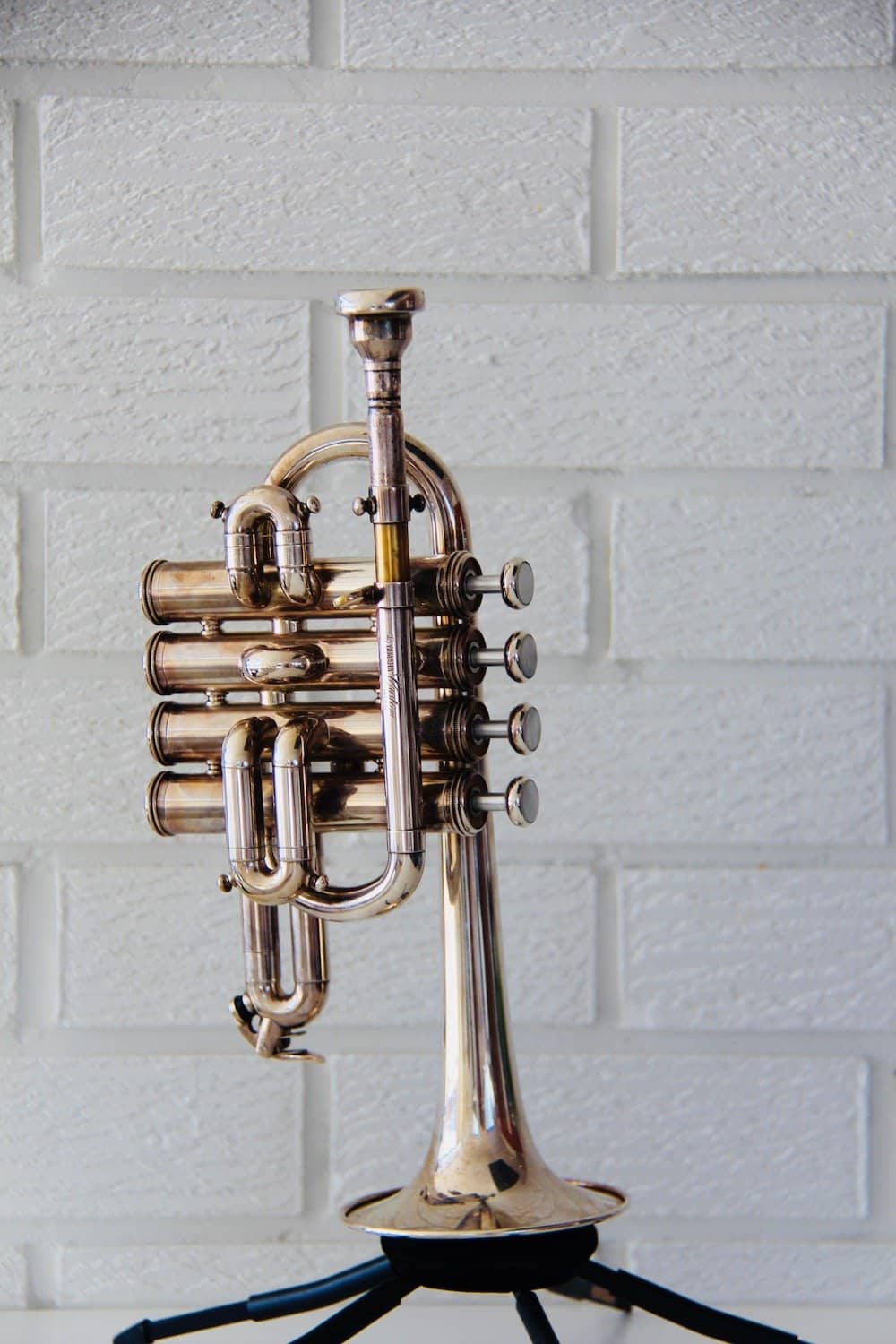
The Fourth Valve
Oh yeah, one more thing about Piccolo Trumpets. The one in the photo above is mine and it has 4 valves for a reason. Most of the time I’m using it in A to play Baroque era D Trumpet parts. Those parts will occasionally have a printed low C so that gets transposed down a 5th (the distance from the A trumpet I’m using down to the D Trumpet it was written for) to F. That F can’t be played reliably with 3 valves so some clever instrument maker added one! I mostly use it to play the low F in pieces like the Handel’s Messiah. I watched a friend use 4th as an alternate fingering on hers last week on that nasty repeated lick at the end of Stravinsky’s Pulcinella Suite. Occasionally a Trumpet player will use the picc in Bb to play a regular Bb part that sits up a little too high and that 4th valve can come in handy as the notes get lower. The solo in The Beatles’ Penny Lane is a Bb Piccolo Trumpet up to its high F. There is a trumpet solo in Mussorgsky’s “Pictures at an Exhibition” that’s usually played on a Piccolo Trumpet in A (but it’s printed for C Trumpet) and requires a Piccolo Trumpet straight mute. Thanks, Ravel, for that purchase.
More Trumpets!
If you are really interested in the full range of trumpets ever made or played there are websites devoted to just that kind of thing. Start at Trumpet-History.com and have fun! This guy has an impressive collection and knows a lot about it.
